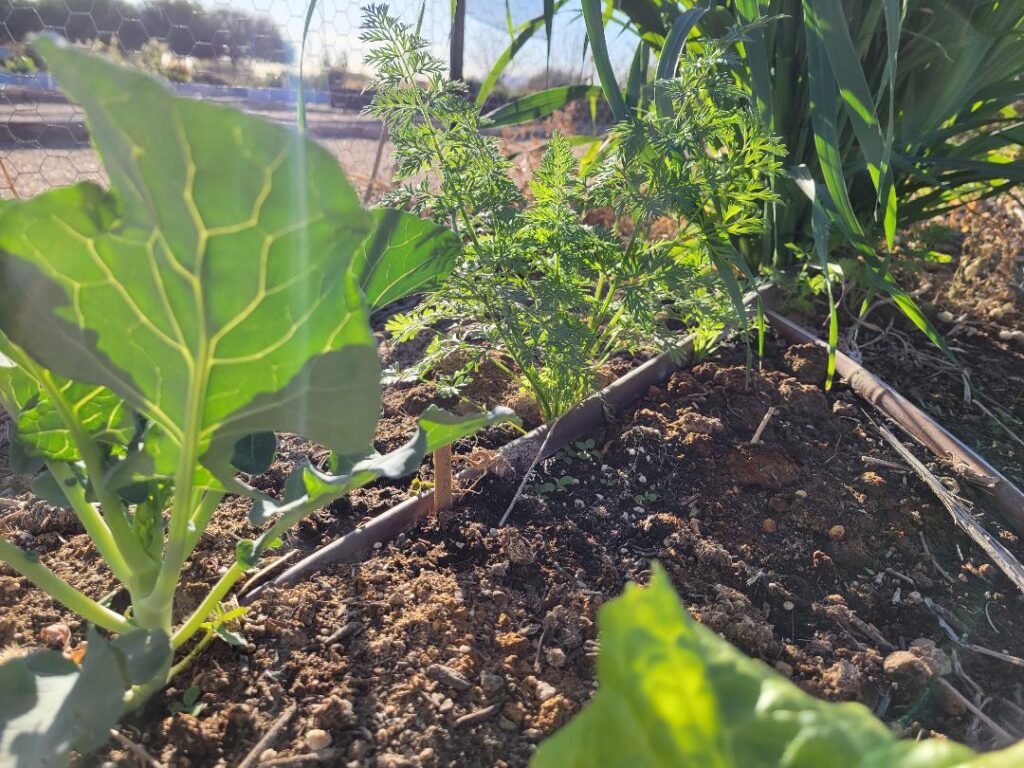My cat Picacho (named for the Peak, near where he found his way into my life) used to beg for carrot tops. And spinach. Broccoli too. If I brought produce-laden groceries home or got out the cutting board to make dinner, Picacho would run into the kitchen, meow excitedly, and nom on the pieces I let fall to the floor. Never the whole thing, mind you. But the game made my cat and me happy.
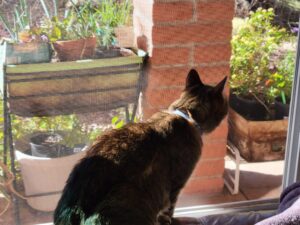
While I learned that his behavior wasn’t quite normal, it wasn’t wrong, either. As a gardener and gardening teacher, I got curious about which plants are good for pets. As a lifelong pet owner, I also pieced together how my cats and dogs enjoy – and yes, sometimes destroy – my garden and yard. Gardening for pets includes not just food but also enjoyable views and interactive spaces. Below is a virtual buffet of pet-friendly projects.
Safety First
Some human foods are good for pets, while others pose real risks.
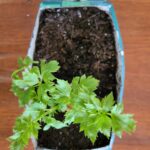
On the short list of good plants for cats are: herbs like dill and parsley, greens like carrot tops and celery, and legumes like peas and green beans. A student in my recent Garden for Pets event reported corn as the cat-pleaser in her home. These all grow great in Tucson, in their respective seasons.
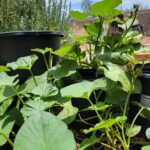
For dogs, try herbs also, root veggies like sweet potatoes and carrots, and watermelon minus the rind. Grass is good for both: oat and wheat leaves are easy to grow indoors year-round or outdoors in winter.
Most pet owners know to not give cats and dogs chocolate – which, sadly, doesn’t grow here anyway. Some popular houseplants, though, are on the NO list: lilly, amaryllis, kalanchoe, and sago palm need to be kept away from pets or not brought home at all. My kalanchoe is on the front patio where neither cats nor dogs even notice. The only sago palm I know is by the turtle pond at school (a pokey nuisance, but certainly hardy).
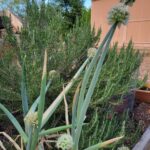
Some human foods surprisingly risky for dogs include grapes, onions, and citrus. If you grow these, be aware of your pets’ access and interest. Reduce access if needed. My medium-sized shepherd mix, for example has nibbled on green onions then left them alone. Even for plants deemed non-toxic, use them only as supplements and watch carefully for individual pets’ reactions.
I recommend visiting the “Poisonous Plants” page of the ASPCA. It’s an impressively lengthy and easily searchable list of plants and their risks – or not – to cats, dogs, and other pets.
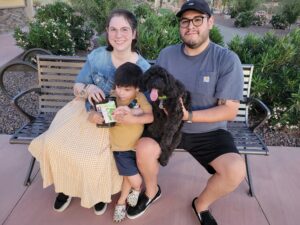
Are you or a company you pay a source of poison in your yard? Before you spray insecticide or weed-killer, weigh the potential risks to pets, humans, and wildlife. Nature to You offers multiple ecology-based lesson topics to help you try safer alternatives.
Outdoors in
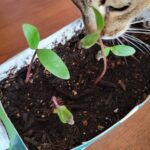
If your cat is indoors-only, smart! Having an indoor pet doesn’t mean cutting off the joys of nature. Instead, it’s a ripe opportunity for pet-owning gardeners. Growing a tray of cat grass (really oats, barley, or wheat when you check the seed packet) or other greens is a healthy start. Turning your own vegetables into toys is certainly an option too. Catnip is an easy herb to grow outside, then dry, and use to enhance playtime any time.
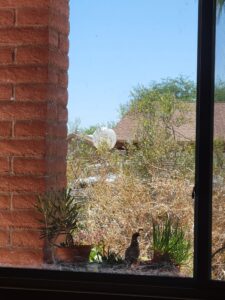
Next, what’s the view like out your windows? Do hummingbirds feed at flowers in your yard? Can your cat see them? Include pollinator-friendly plants in a part of your yard to which your cat has visual access. Enjoy the show of your pet chattering and drooling at a bird hovering just out of reach. Do bunnies and quail scuttle in and out of shrubs? Let your native plants grow naturally and brush the ground to make enticing wildlife habitat. Let those same plants grow in sight from a window where your cat can perch. Conversely, I have sacrificed plants in a front patio flowerpot by allowing a bunny to cool off in the moist soil on a hot day. The outdoor animals benefit from rich habitat while staying safe from domestic predators. The cats and dogs on the air-coniditioned side of the glass benefit from live entertainment.
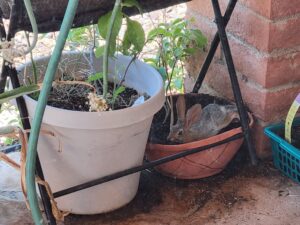
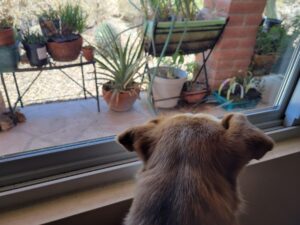
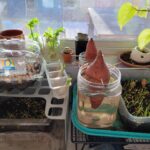
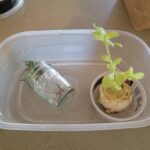
If you have a windowsill or countertop garden of pet-safe plants, decide for yourself how much you want your cat to interact with it. Consider rotating pots so each plant gets a turn to keep growing. Clear the area of papers or decorations that would get damaged by inevitable spills. If your cat is like my large tabby, expect knocking over jars and pots to be part of his fun. Situate any fragile containers according to your own level of acceptable risk. Experiment with plant-protectors such as a table-top greenhouse, plastic or wire covers, or separate shelves for cats vs. plants until you find your peaceful compromise.
Sharing the backyard
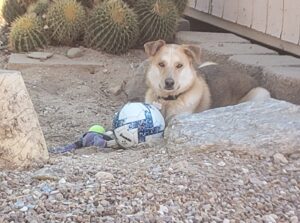
You want to enjoy your backyard. So does your dog. Are there sources of conflict between your wishes and your dog’s actions? First, check that the dog has access to basic needs: fresh water to drink, a clean area to play, a shady spot AND a sunny spot most of the day. Go a small step further by providing – or allowing – moist soil to dig and something safe to chew. The catch for many gardeners is that your garden bed should not be the dog’s place to dig and chew…. What to do?
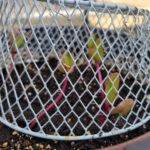
You can protect parts of your garden on a small or large scale. Put pots up high, or grow veggies and favorite flowers in your front yard instead of the back. Add hardware cloth (It’s like chicken wire, with thicker wire and smaller holes.) around beds, or invest in wire baskets to pin over certain plants. If you have the space and budget, use raised beds – you may still need hardware cloth – or fence part of your yard to ease inter-species stress. You can also compromise. For example, let the dog rearrange one garden bed while you maintain control over others. Or protect young plants, then allow your dog access later on when a little chewing won’t kill the mature plant. By the way, I have used these strategies as much for my kids and for wild critters as I have for my pets.
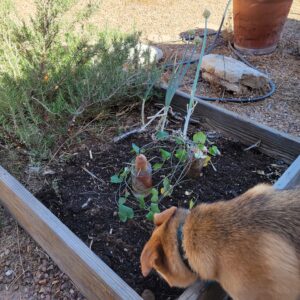
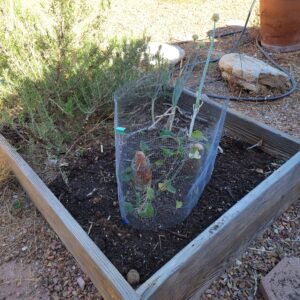
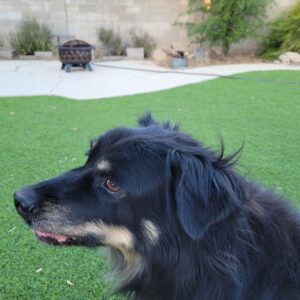
What can you and your dog enjoy together outside? My dog feels special when I let her drink out of the hose while watering my plants. When I walk around to check on plants with my eyes, she tags along with her nose. We keep each other company while I weed, me busy while she sits and looks pretty. My older dog was most comfortable laying in the artificial turf, especially as his body wore down. His tail would thump when I sat down by his side, and we could comfort each other. Nearly to the end, he and I shared a love for compost too: me making it, him stealing dried cobs of corn or crunchy newspaper to chew on. I smiled and let him.
I hope these examples have given you some project ideas to chew on too. You and your pets will find the best balance of plants and adaptations for your unique goals and personalities.

